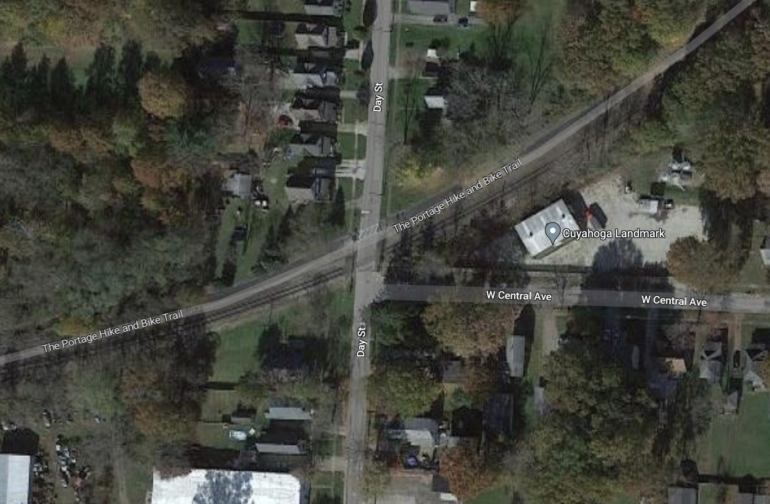Ravenna City Council has a decision to make: They can split Day Street in two or wait years for the state to approve upgraded crossings at Day and Chestnut streets.
The choice comes from ABC Railroad, which owns the tracks that intersect Day Street. If city leaders agree to close the crossing, the only question is what the ends of the street will look like: a cul-de-sac, which Fire Chief Mark Chapple recommends, or a simple and cheaper dead end.
Rail project specialist Tom Persinger of the Public Utilities Commission of Ohio (PUCO) is expected to present ABC’s proposal to Ravenna City Council’s Streets & Sidewalks Committee during council’s regular meeting at 6 p.m. March 13. City Council President Andrew Kluge is encouraging residents to attend because he is hesitant to close Day Street without the input of those affected.
The State of Ohio has a goal to close as many crossings as possible, and ABC wants to close the Day Street crossing because it is a residential road that logs the least number of railroad crossings of any in the city, said Andy Shuster, the railroad company’s signal specialist. Day Street connects Highland and Lincoln avenues.
“Railroad crossings are very dangerous,” Shuster said. “We all know that, so if there’s a possibility to eliminate them, we try to do so. The State of Ohio put together a program where if you can eliminate a crossing, then they will pay to upgrade another crossing in the vicinity 100%.”
Motorists traveling Day Street from the south would be directed to West Central Avenue. Those approaching from the north would simply hit a dead end. On both sides, ABC would install guardrails and reflectors at the tracks to catch the attention of motorists, Shuster said.
The north approach, though, presents a problem for the fire department. Chapple wants enough room on the road for the city’s ladder truck to be able to turn around. A dead-end road won’t do it, but a cul-de-sac would.
“We need to be able to at least do a three-point turn to head back out. Otherwise, we’d have to back up all the way down the street, which is not feasible,” Chapple said. “If they close it, the cul-de-sac is the only thing that would make sense for us to be able to turn around in there.”
The state is willing to kick in $8,000, Shuster said.
That, however, is a drop in the bucket for a project estimated to cost $150,000 to $200,000, not to mention additional funds to purchase needed property from a Day Street homeowner, Ravenna City Engineer Robert Finney said.
“We will not pay for it,” he said. “If this project is going to get done, the railroad or PUCO would have to pay for it. The city will not use our money to pay for a cul-de-sac.”
That, even though Finney recognizes that a cul-de-sac would benefit not only fire trucks, but also delivery trucks, city plow trucks, and trash and recycling trucks, as they would not have to back into residents’ driveways to turn around.
Ultimately, city council members will determine the project’s fate and the parties will have to accept the consequences of their decision, Finney said, foreseeing what he anticipates will be an “interesting discussion” with that legislative body.
“I don’t believe council’s going to be willing to spend it,” he said. “We have the money to do it, but that means other things aren’t getting paved. I don’t believe council’s going to be willing to trade off.”
Insisting that ABC will “help where it can” short of funding the entire cul-de-sac project, Shuster said the choice between closing Day Street or putting off critical crossing upgrades for years is a no-brainer.
“If they are willing to close the crossing at Day Street, the State of Ohio will pay 100% to have that crossing at Chestnut upgraded,” Shuster said.
By crossing upgrades, Shuster means LED lighting and high-visibility automatic gates and crossbucks. (Crossbucks are the X-shaped signs that indicate level railroad crossings.)
Should city leaders agree to close Day Street at the crossing, the state will automatically approve upgrades at the Chestnut Street crossing, Shuster said. However, if city leaders balk at the closure, upgrading the Day and Chestnut street crossings could be years in the future, he warned.
With a railroad spur already in place for LG Chem (located near the former GE plant on North Chestnut Street) and one planned for Menards, which will be sited between Freedom Street and Peck Road, Shuster said Ravenna can expect more rail traffic.
That being the case, a high-visibility crossing at Chestnut Street is even more important, especially due to the proximity of a hike-and-bike trail that runs parallel to the road. The trail crosses the spur that leads to LG Chem, but Shuster said the train at that point would be proceeding so slowly that the engineer and conductor would notice hikers and bikers well in advance.
Ravenna’s Freedom Street and Cleveland Road crossings have already been upgraded, Shuster said. Depending on how fast the state approves ABC’s proposals, work on the Oakwood Street and Diamond Street crossings could begin in late summer.
Though Kluge supports safer crossings, he said he is concerned about closing Day Street. Once it’s closed, he pointed out, there’s no going back.
Having grown up in Canton, where multiple roads dead-end at railroad tracks, Shuster said he was surprised to learn that there might be opposition to one in Ravenna.
“That’s not my argument to have,” he said. “If the City of Ravenna doesn’t want a dead-end street, then they need to figure out how to not make it a dead-end street, but that’s not on the railroad to do that. That’s on the city engineers.”
Wendy DiAlesandro is a former Record Publishing Co. reporter and contributing writer for The Portager.

